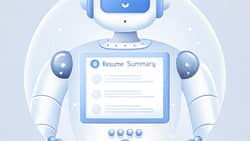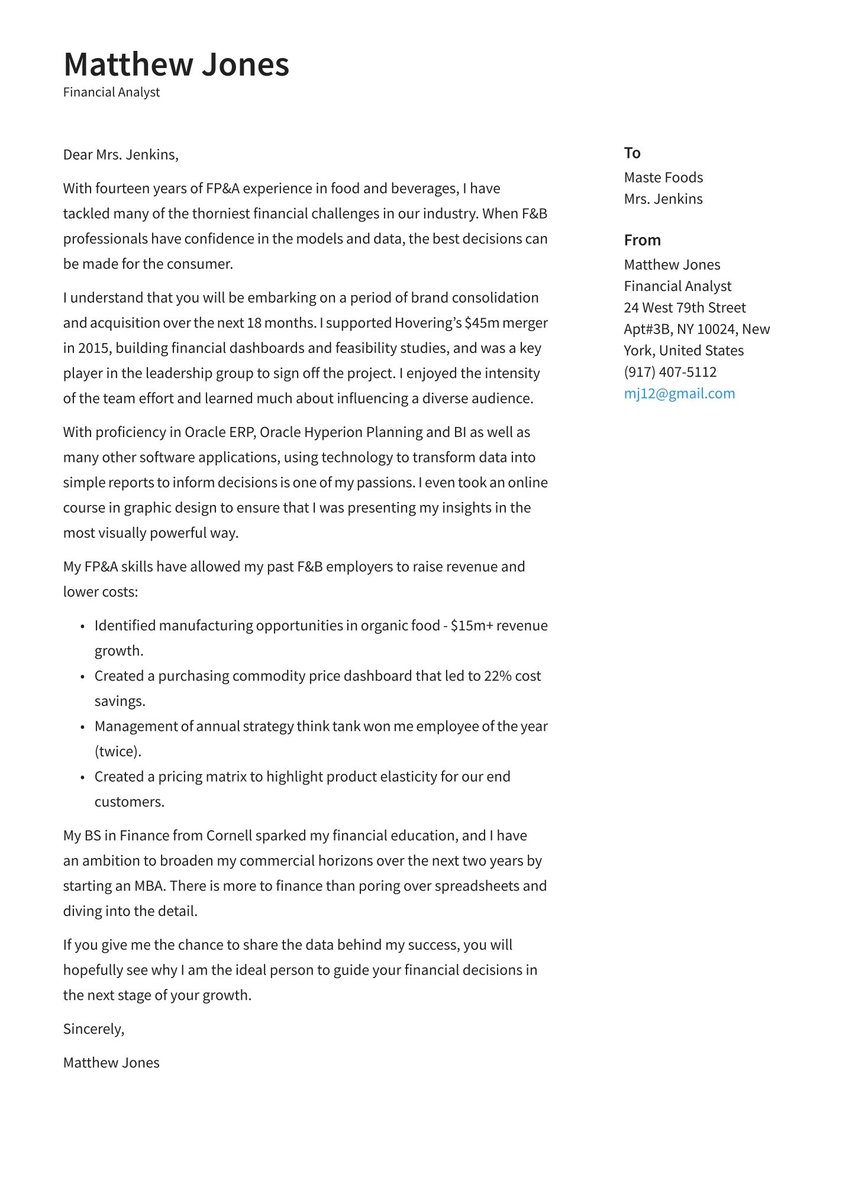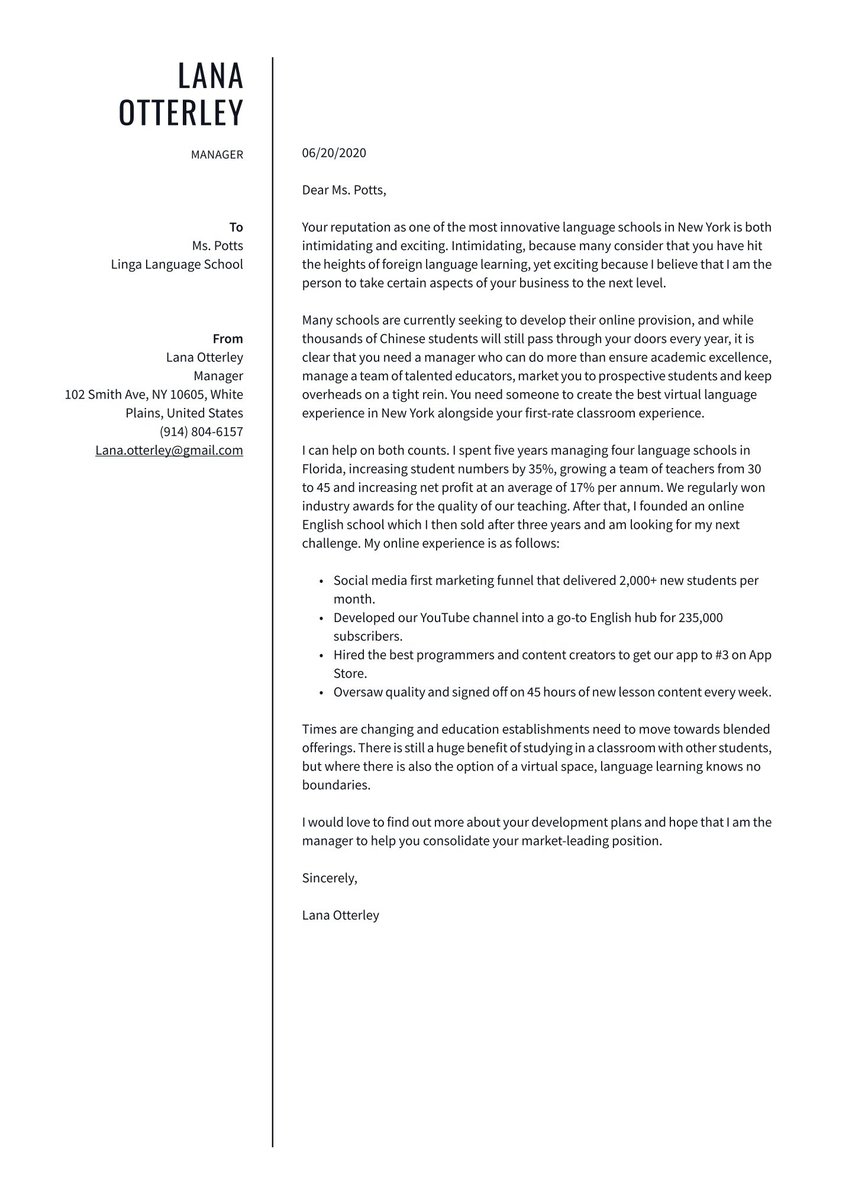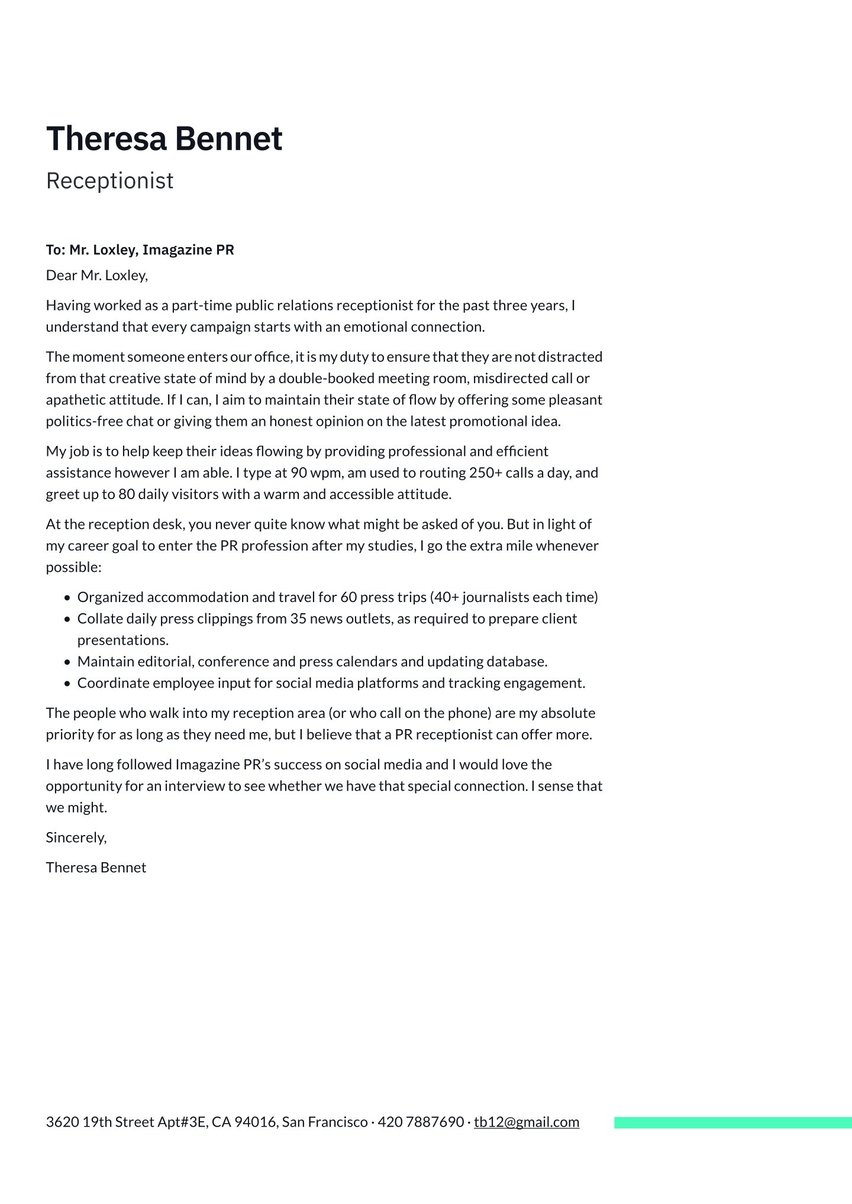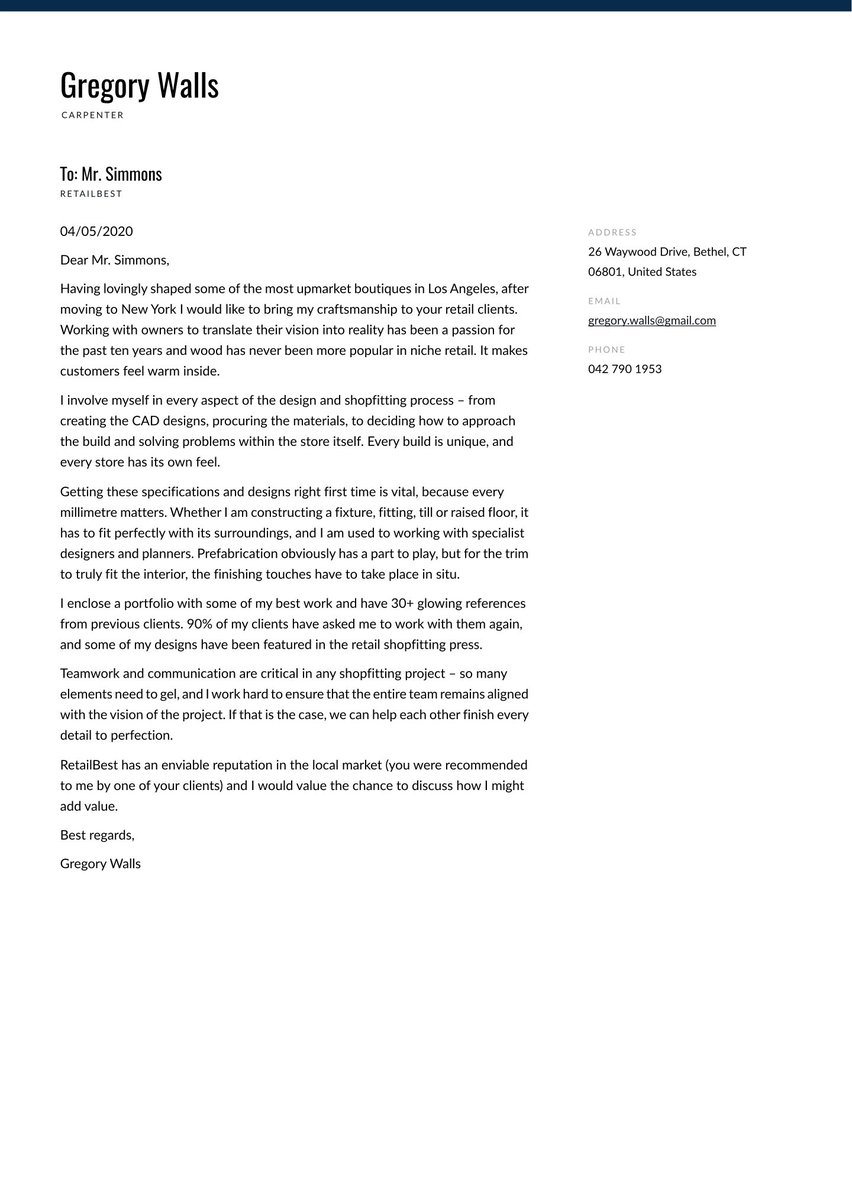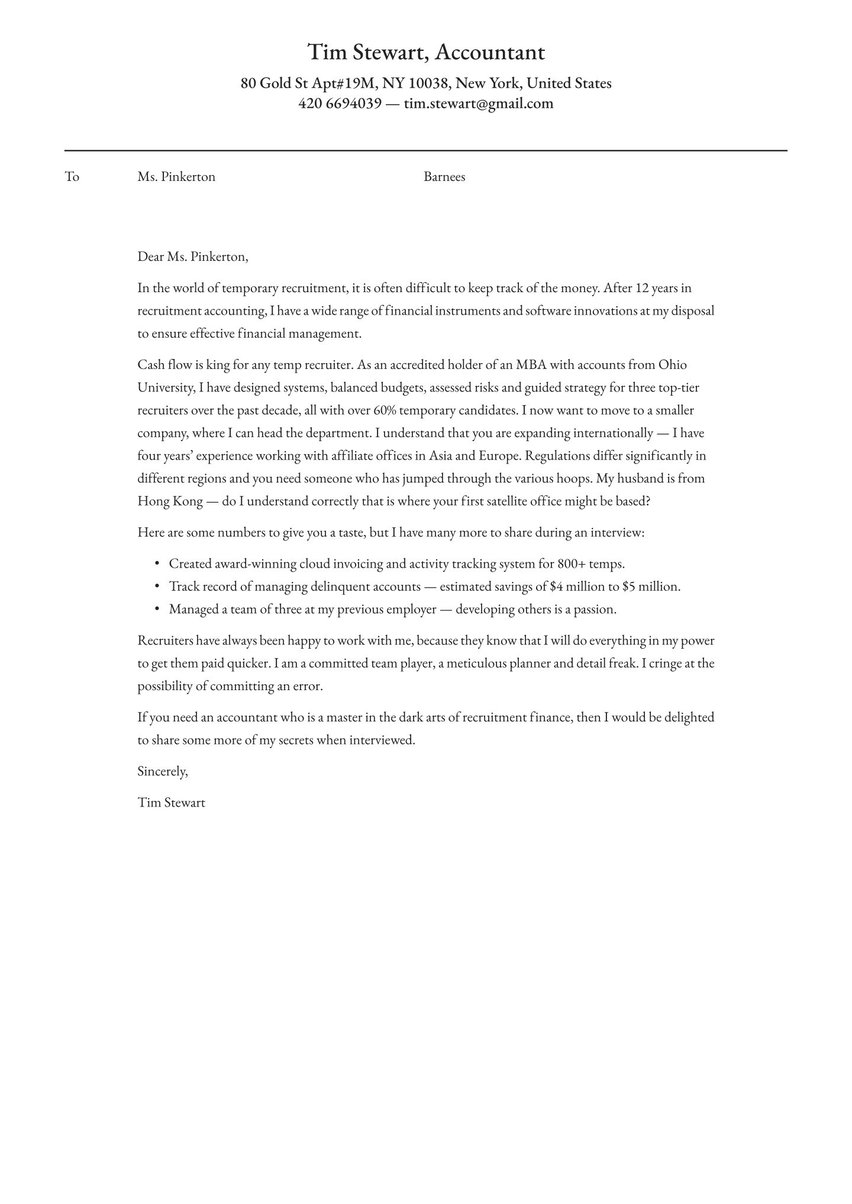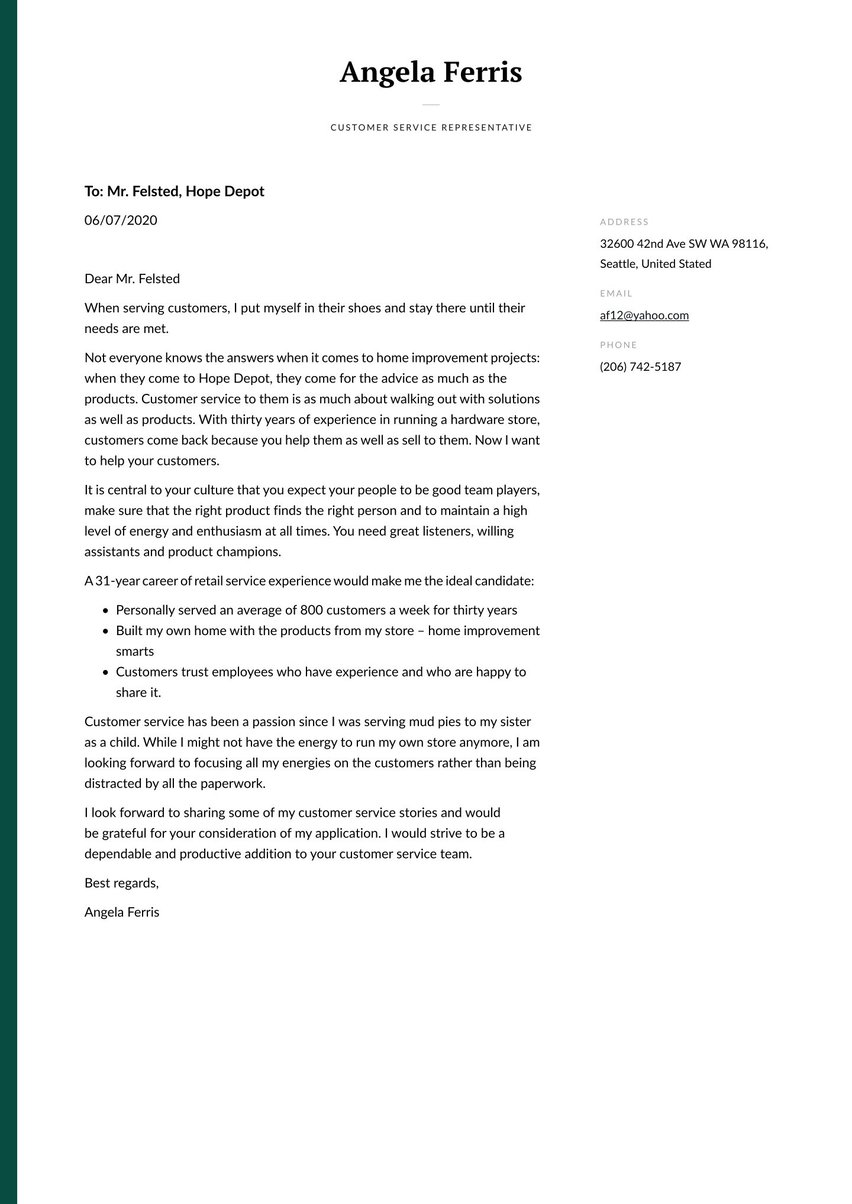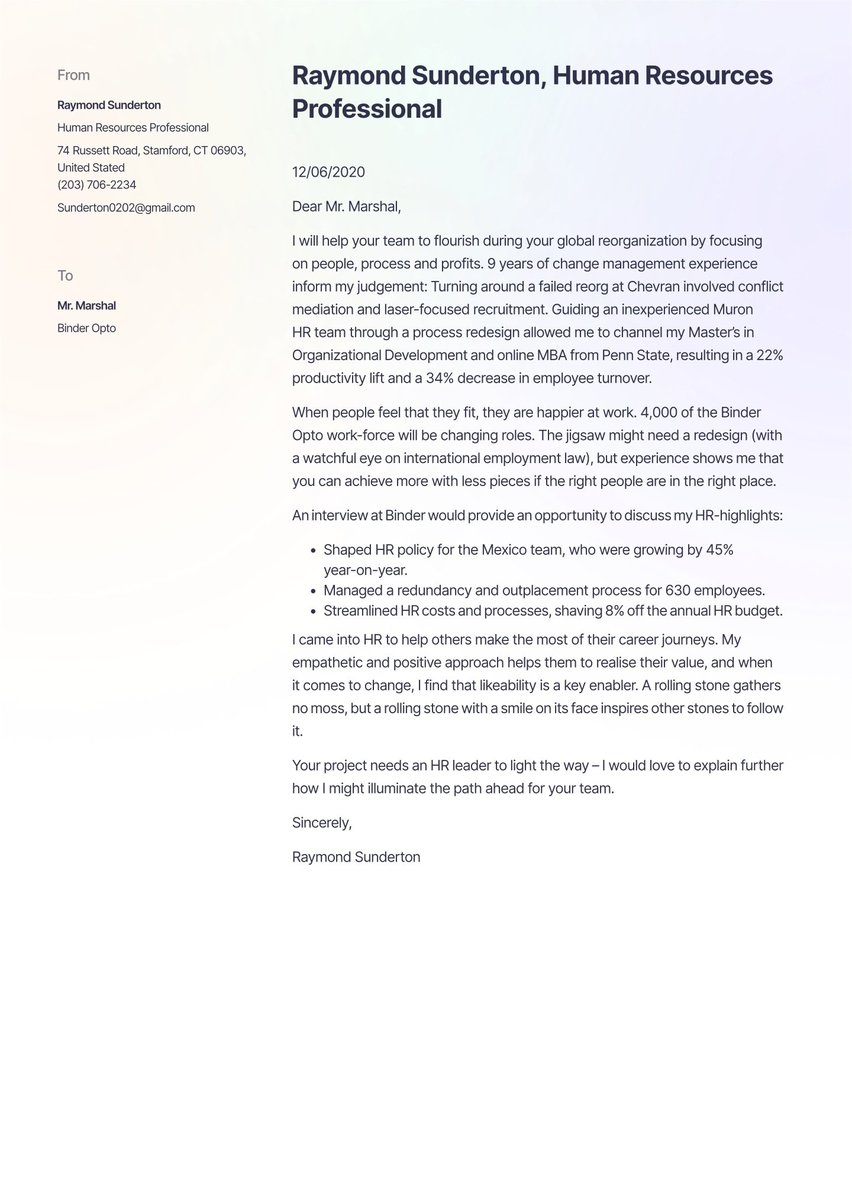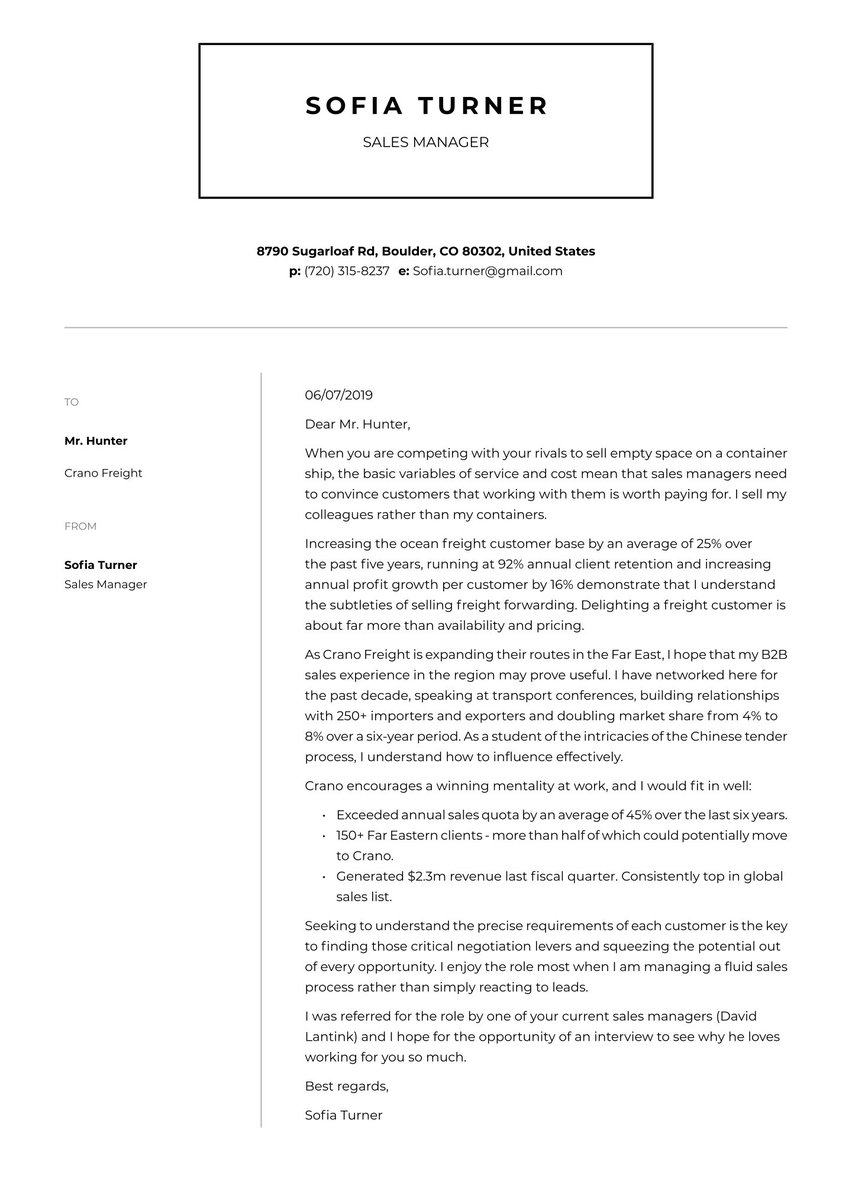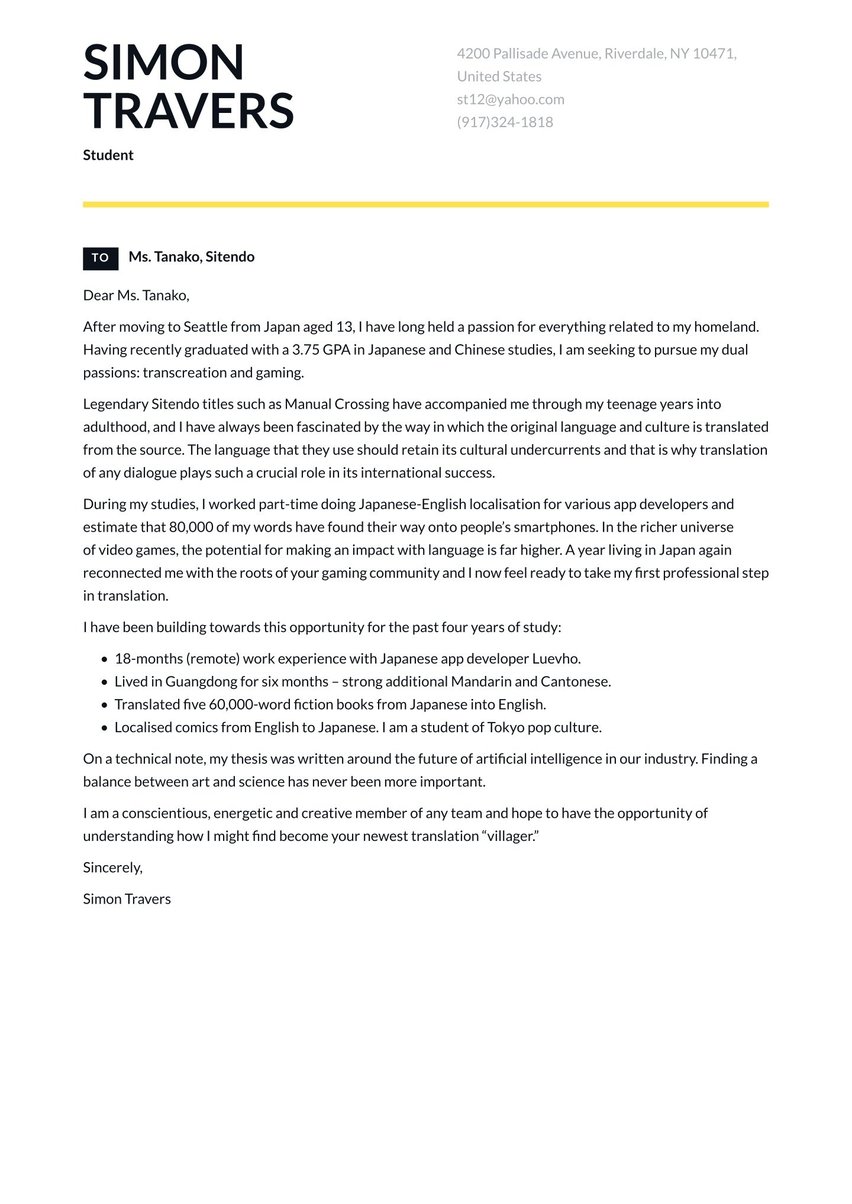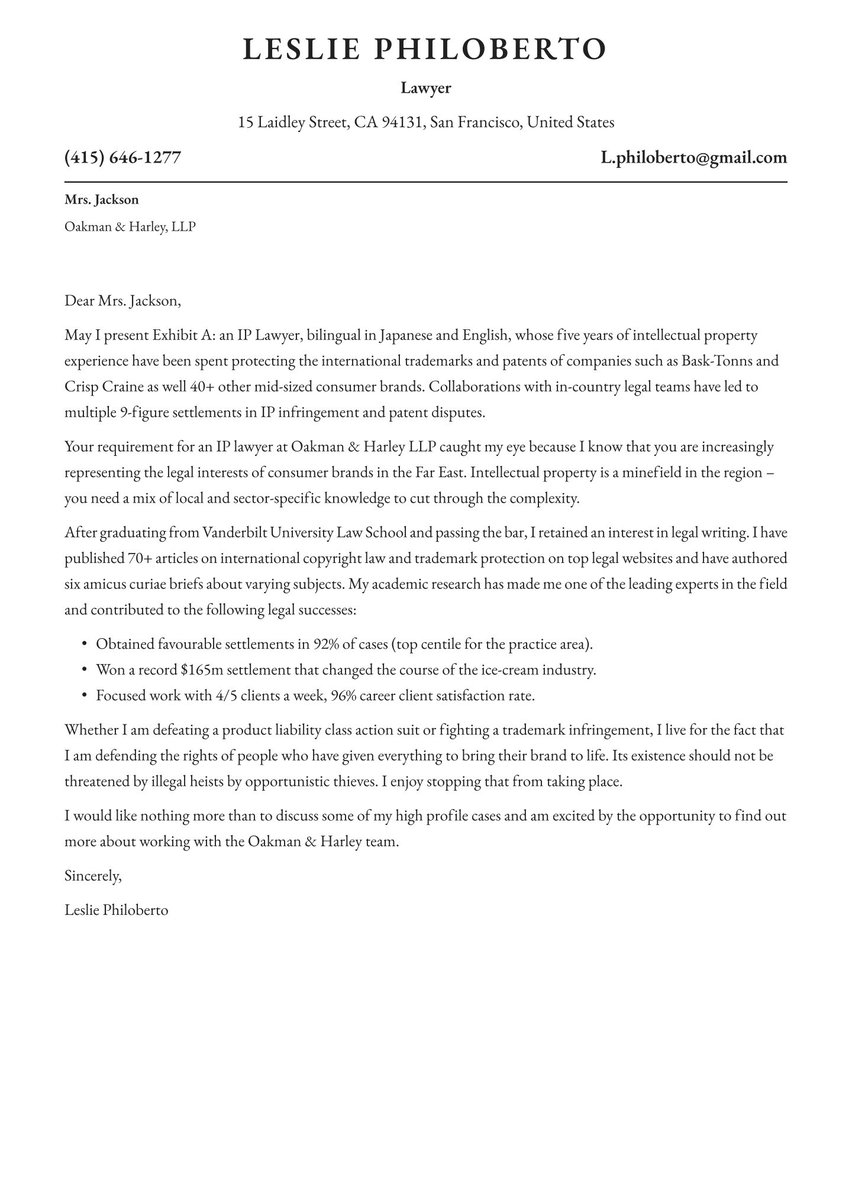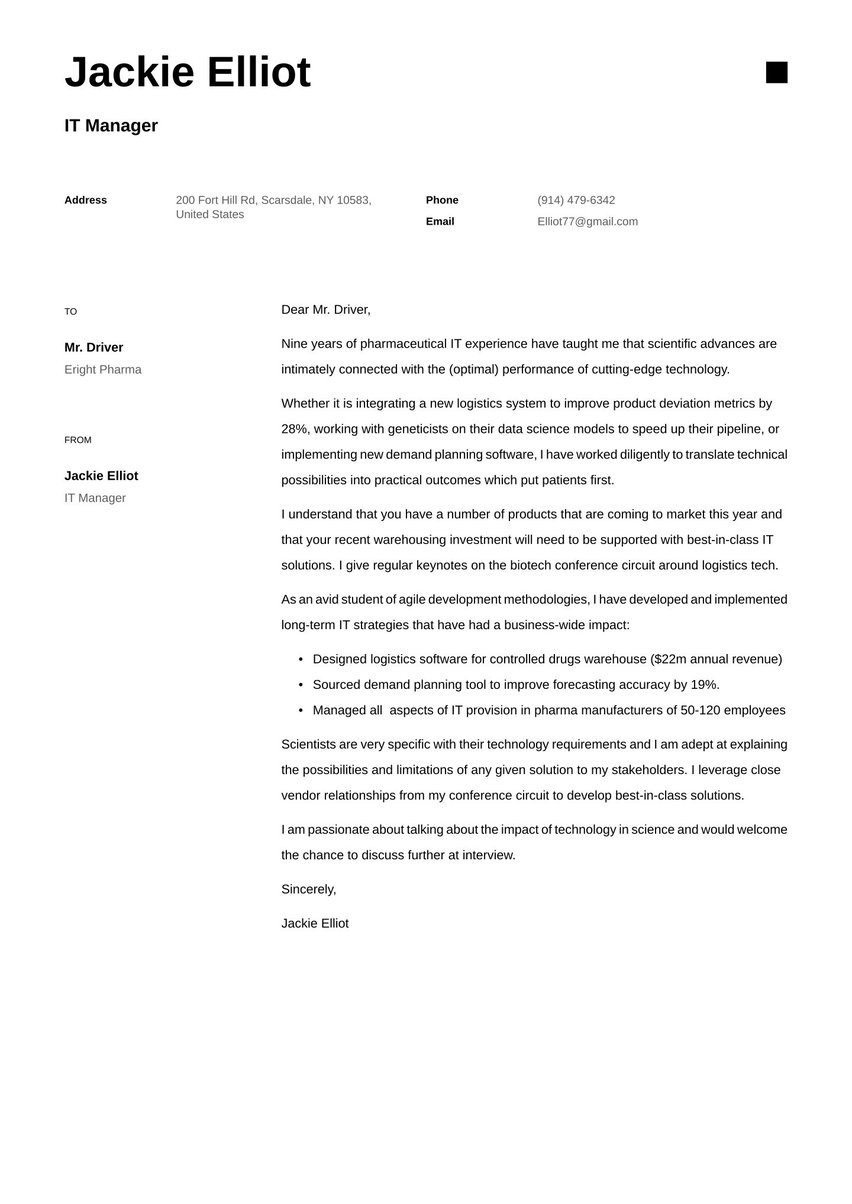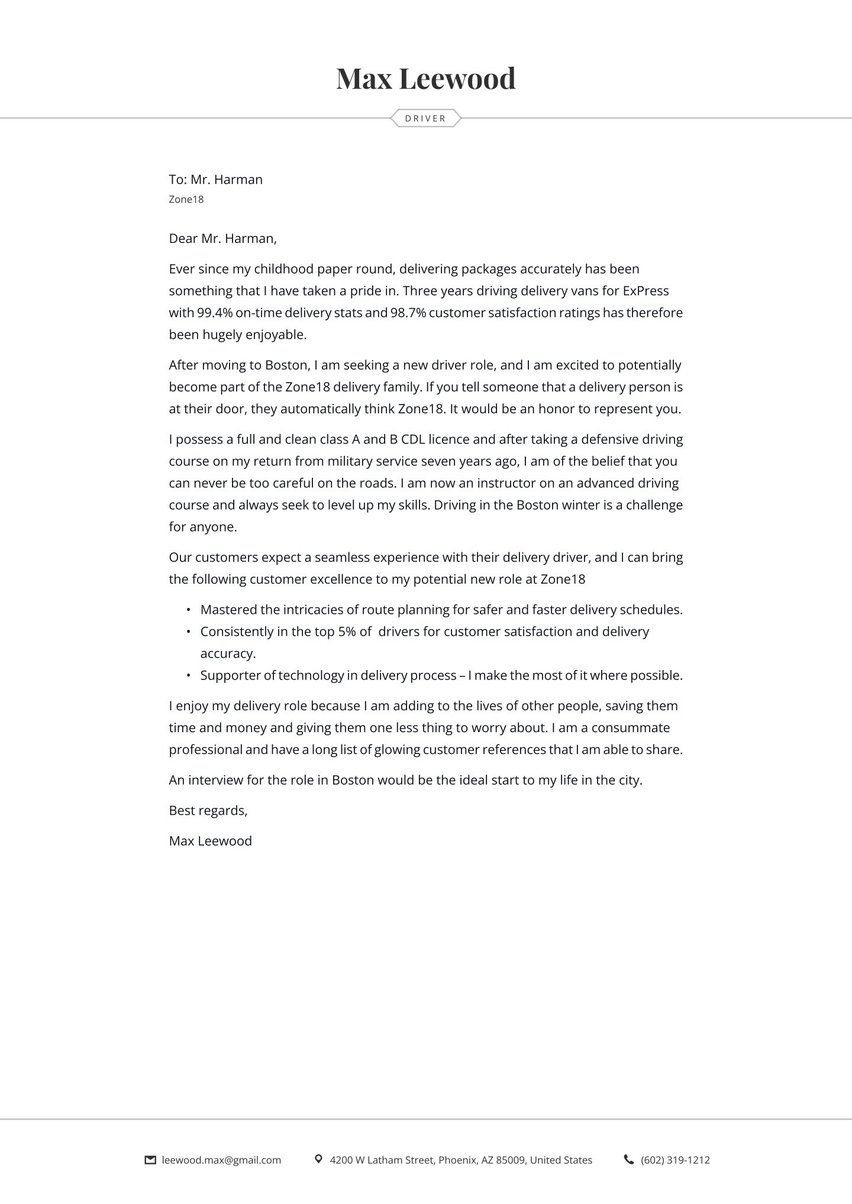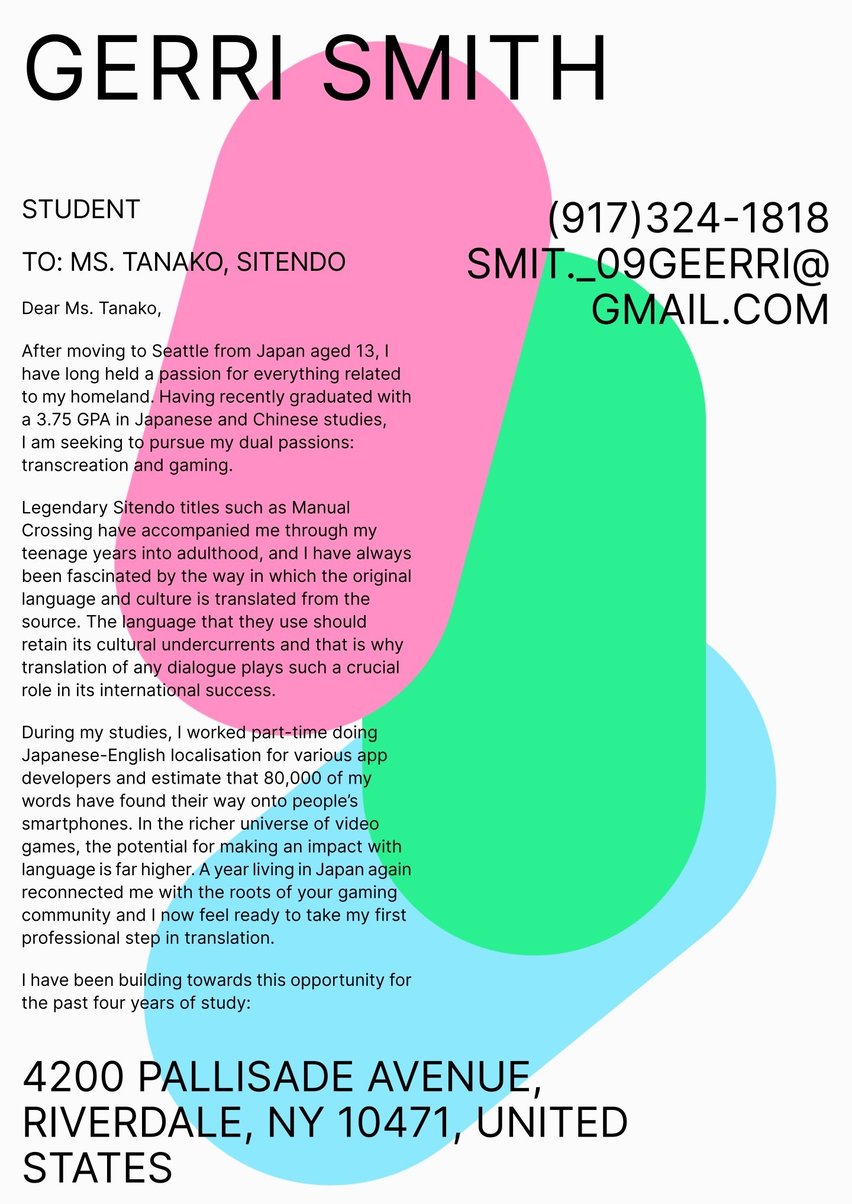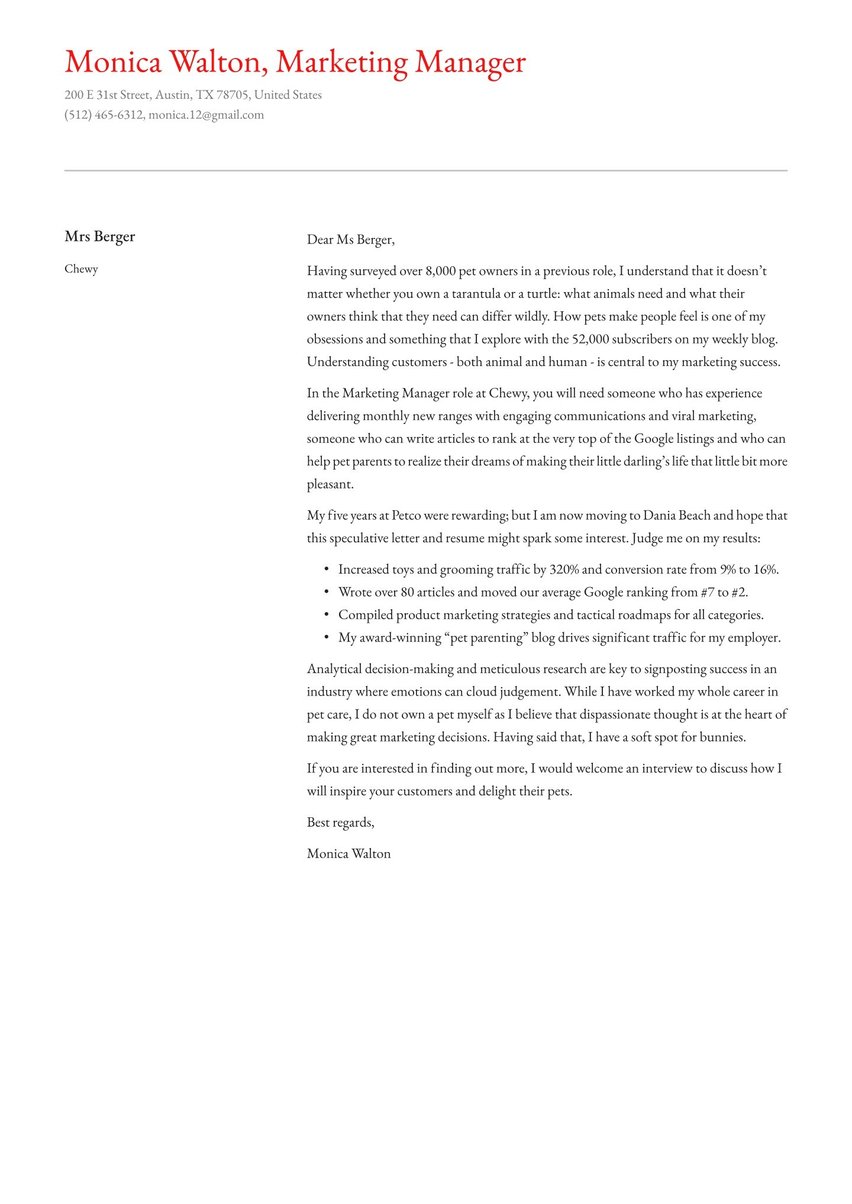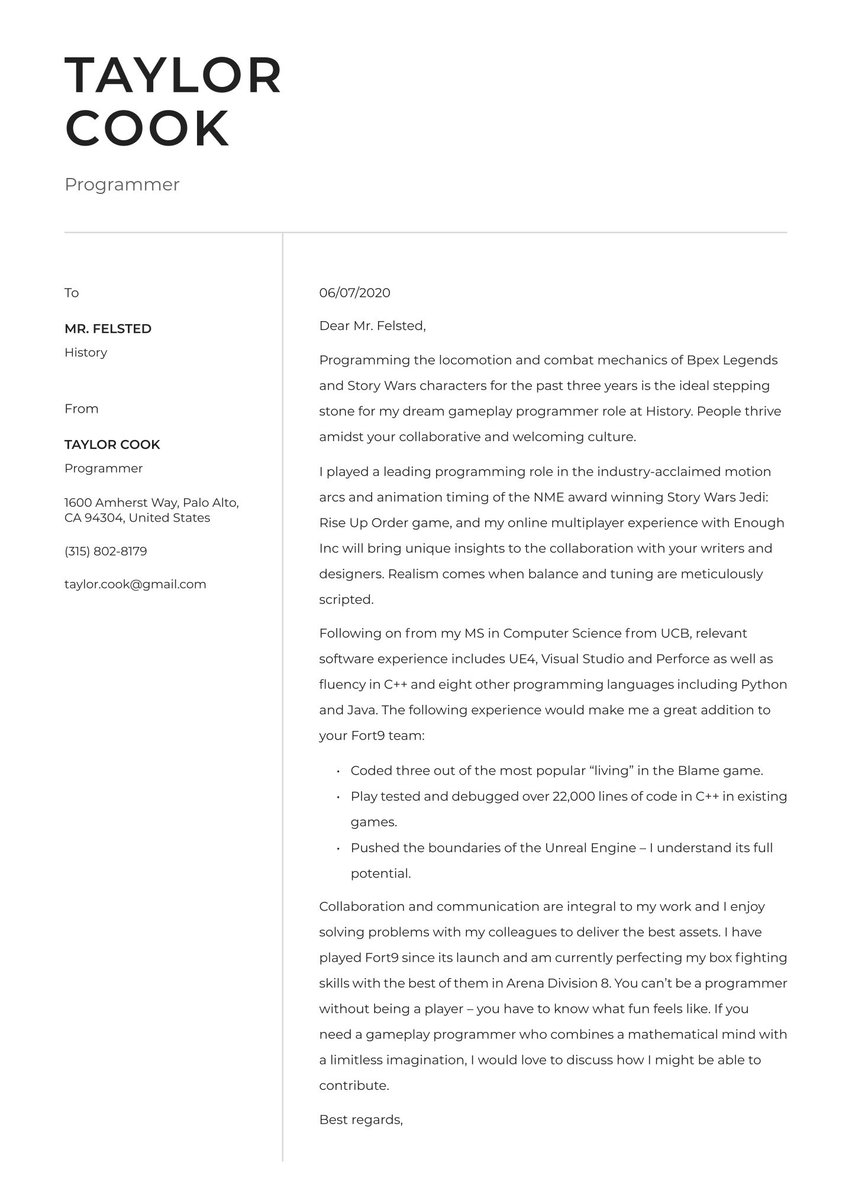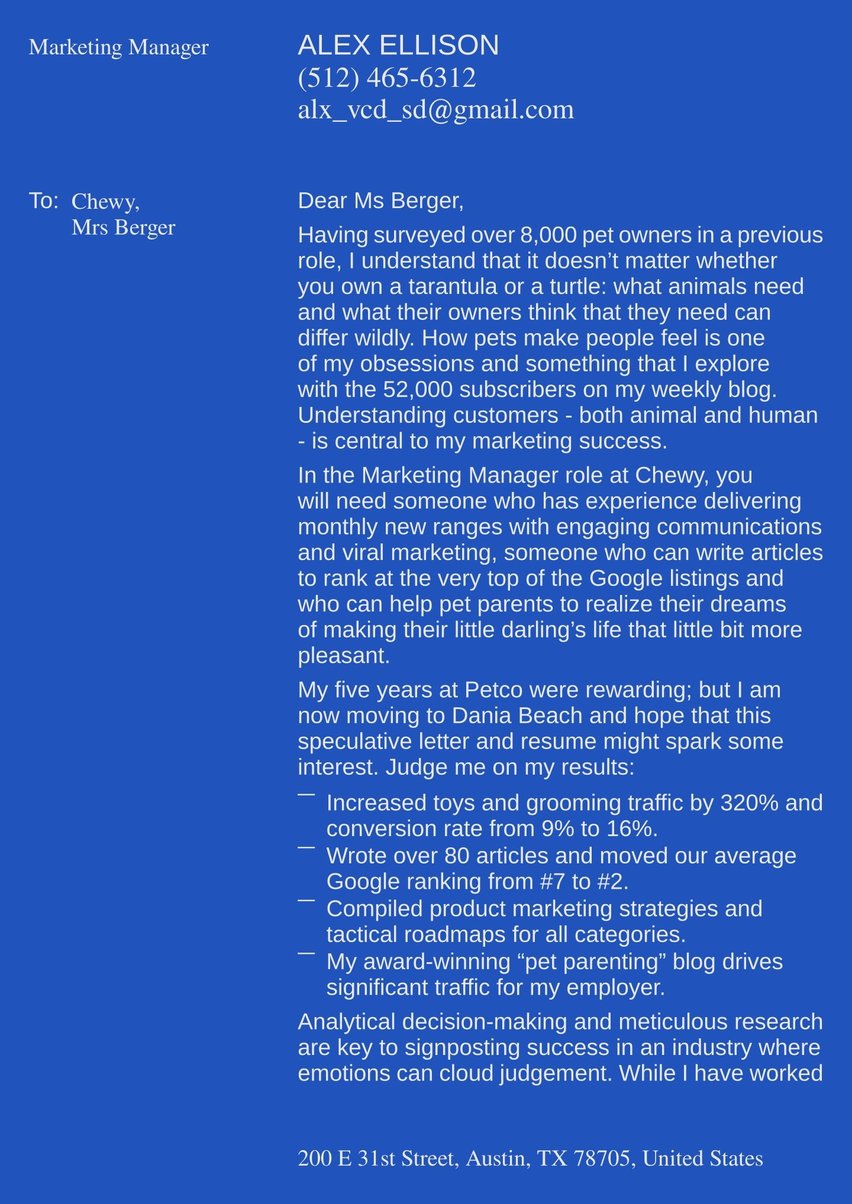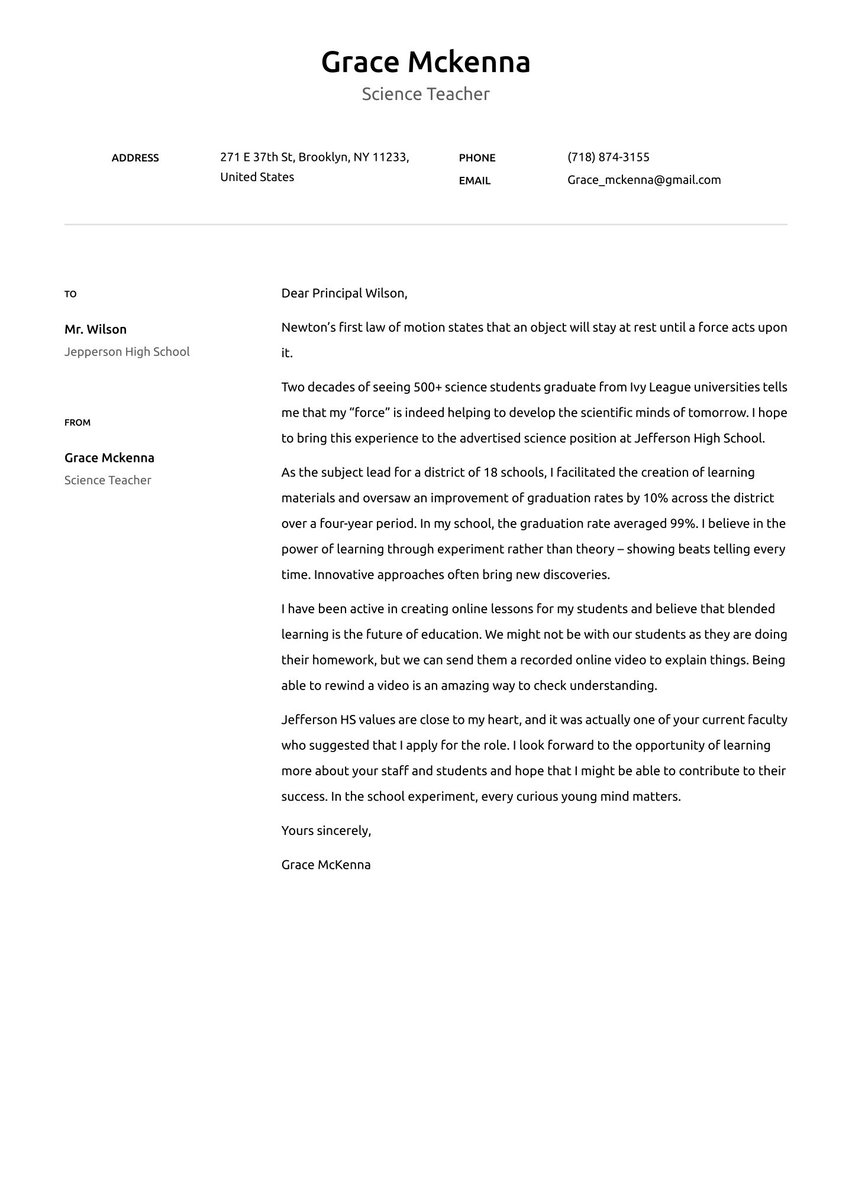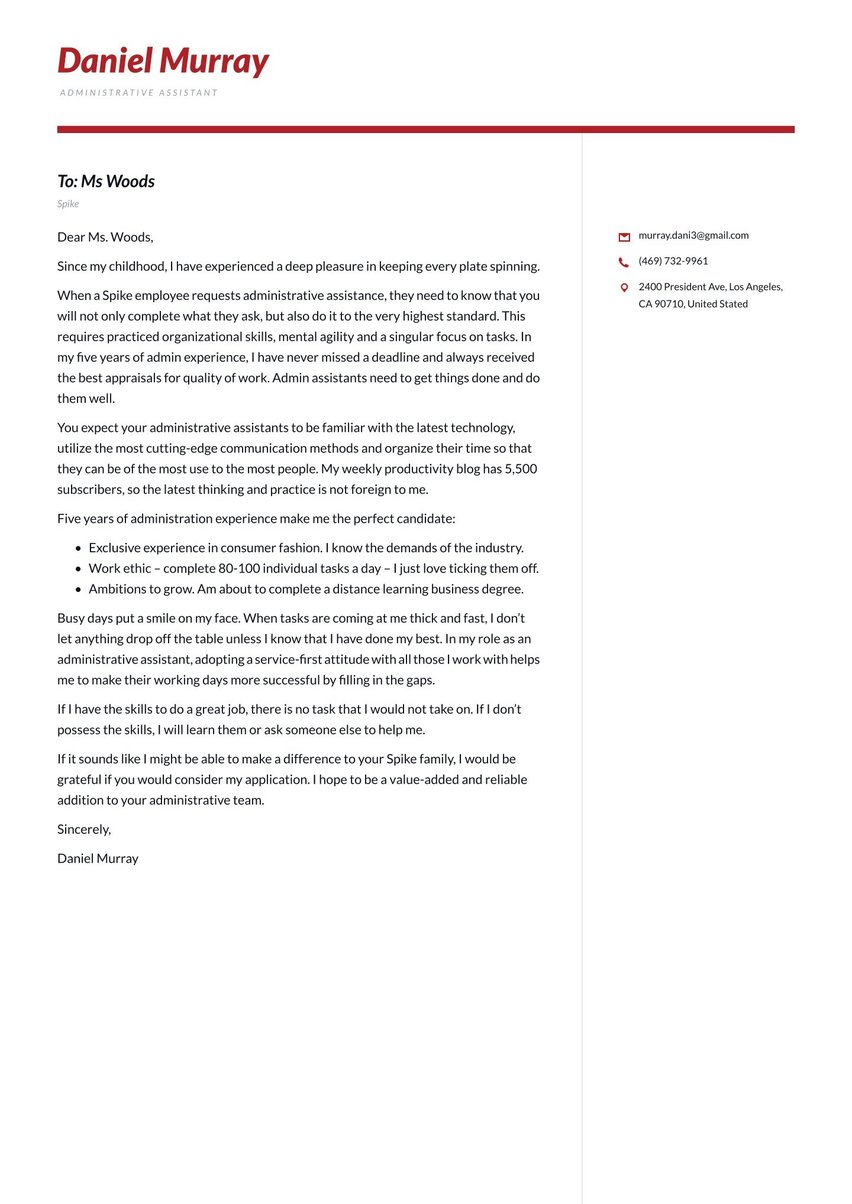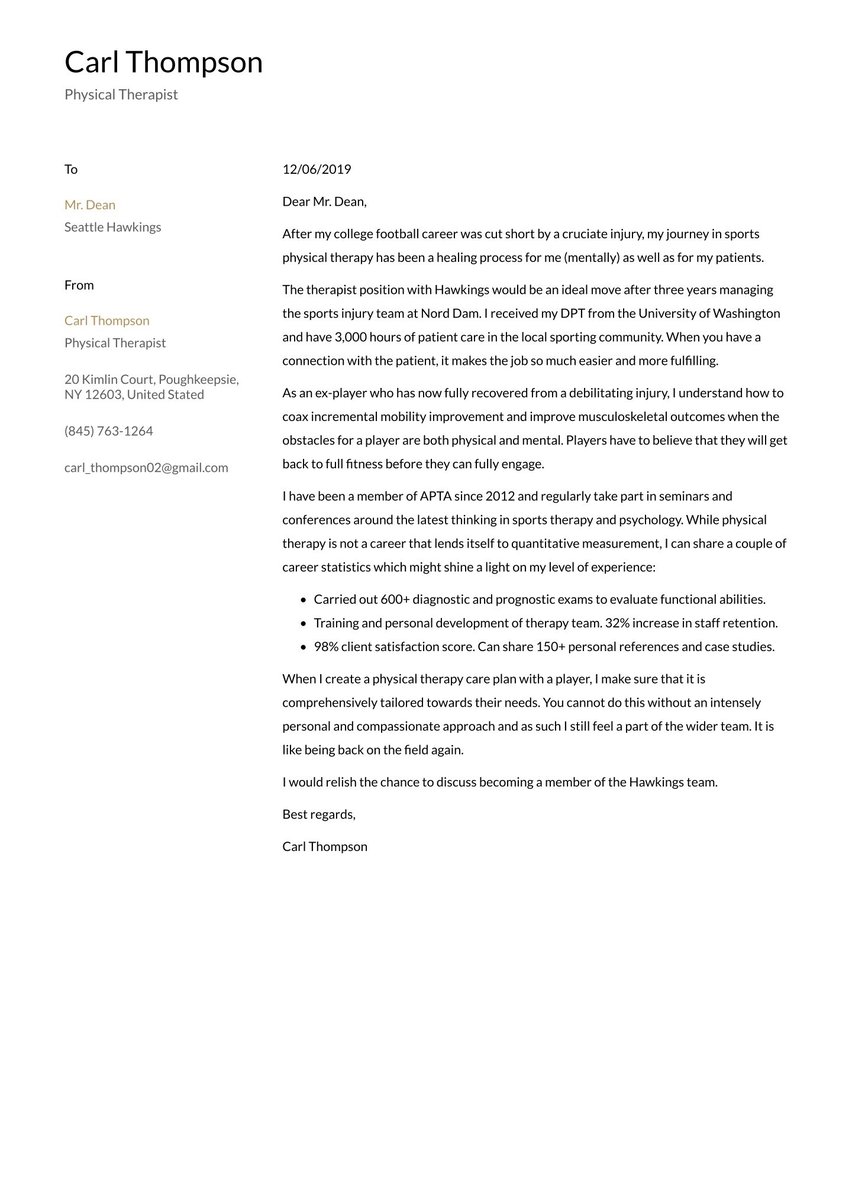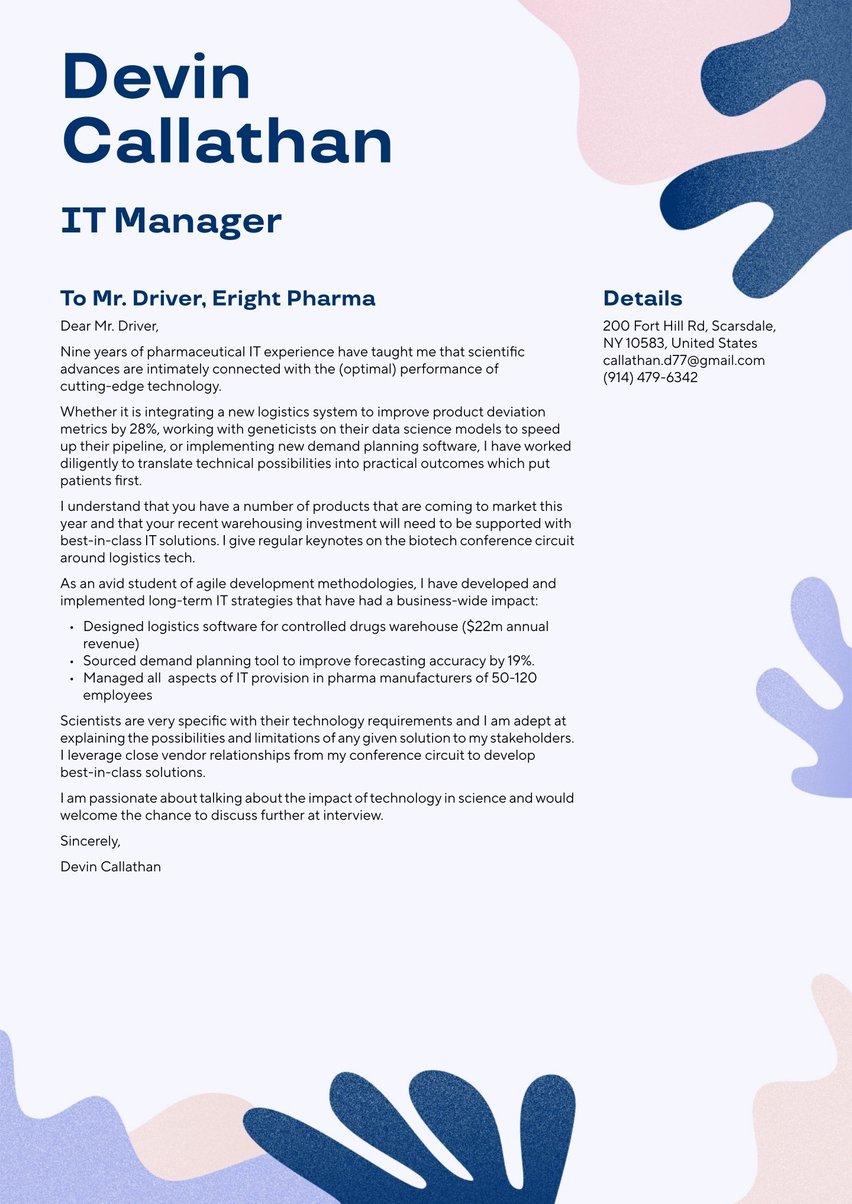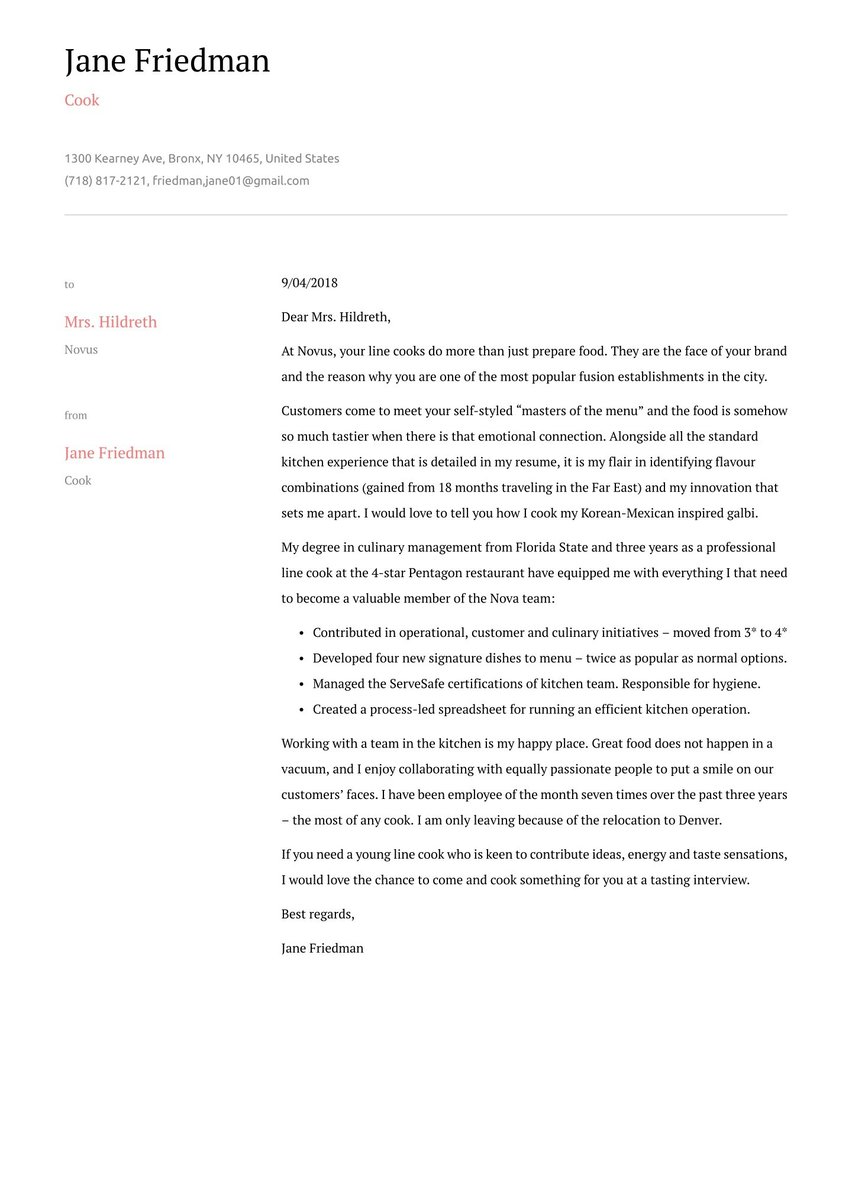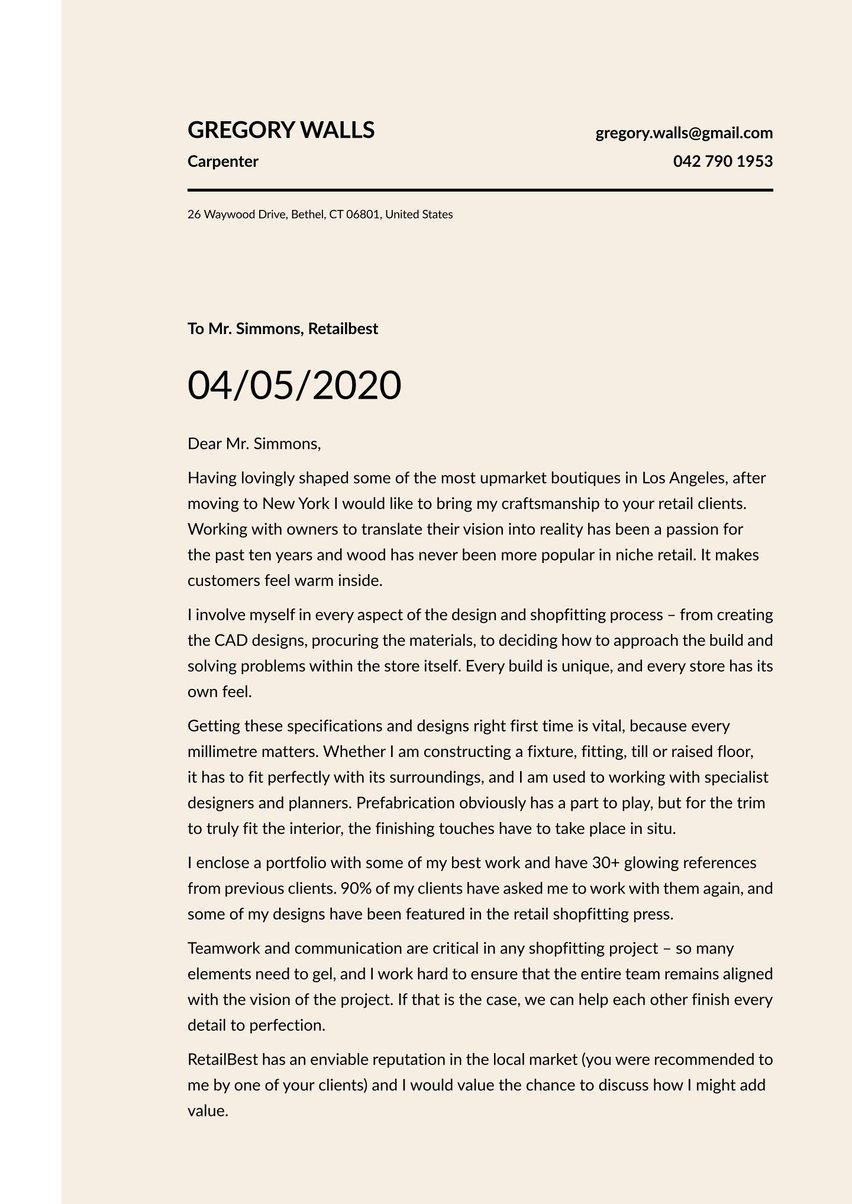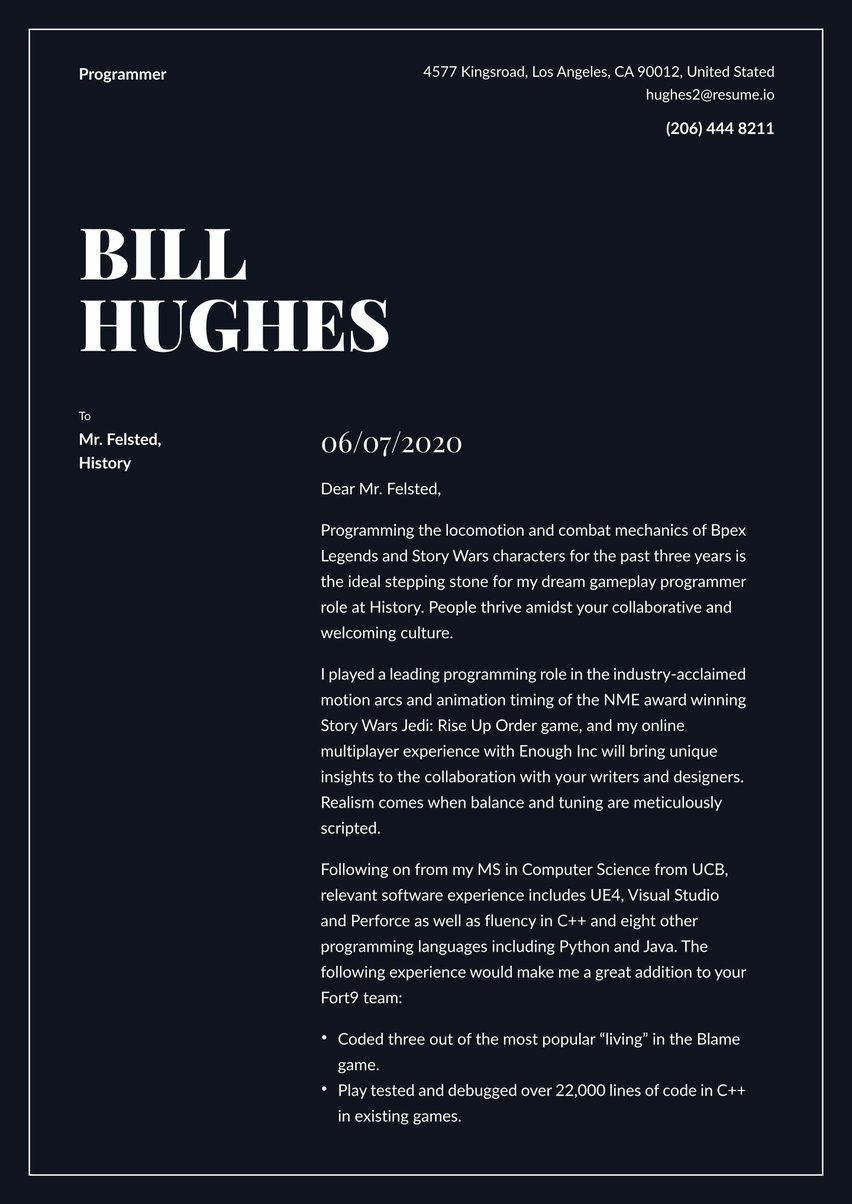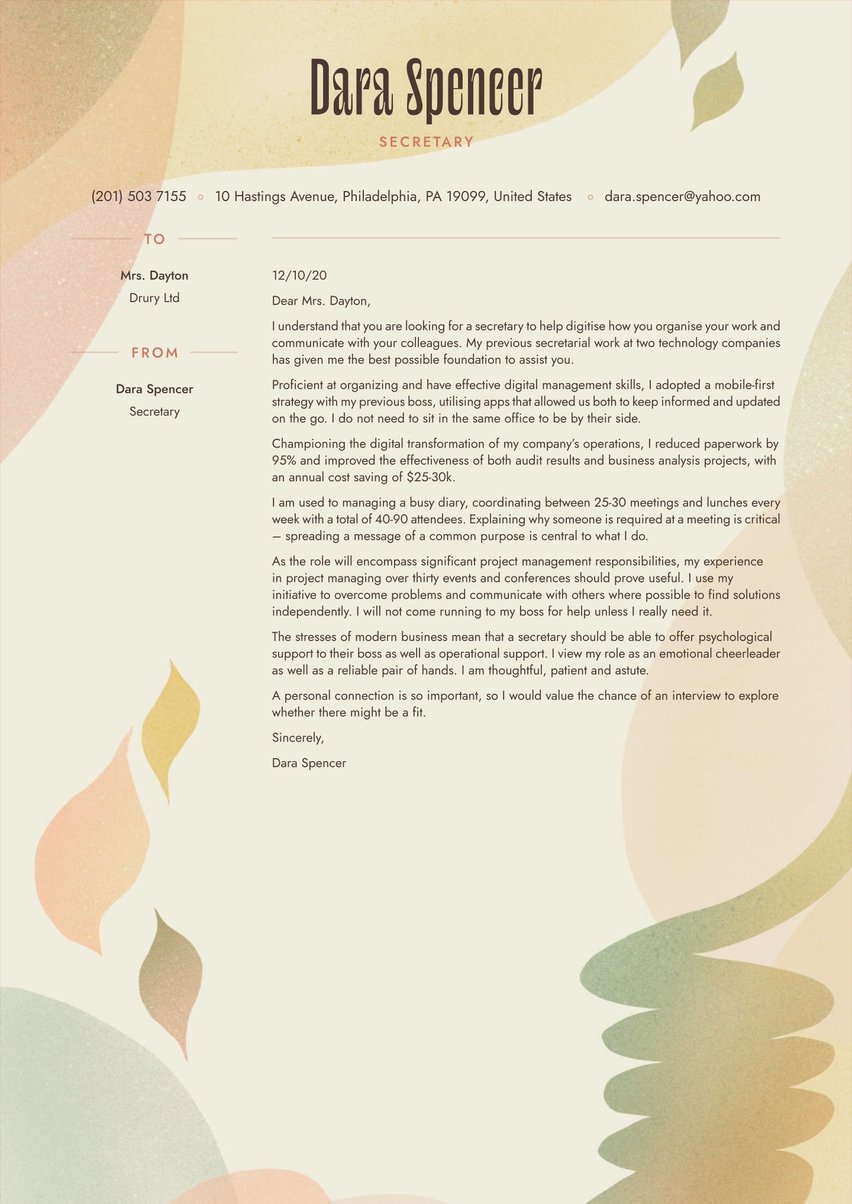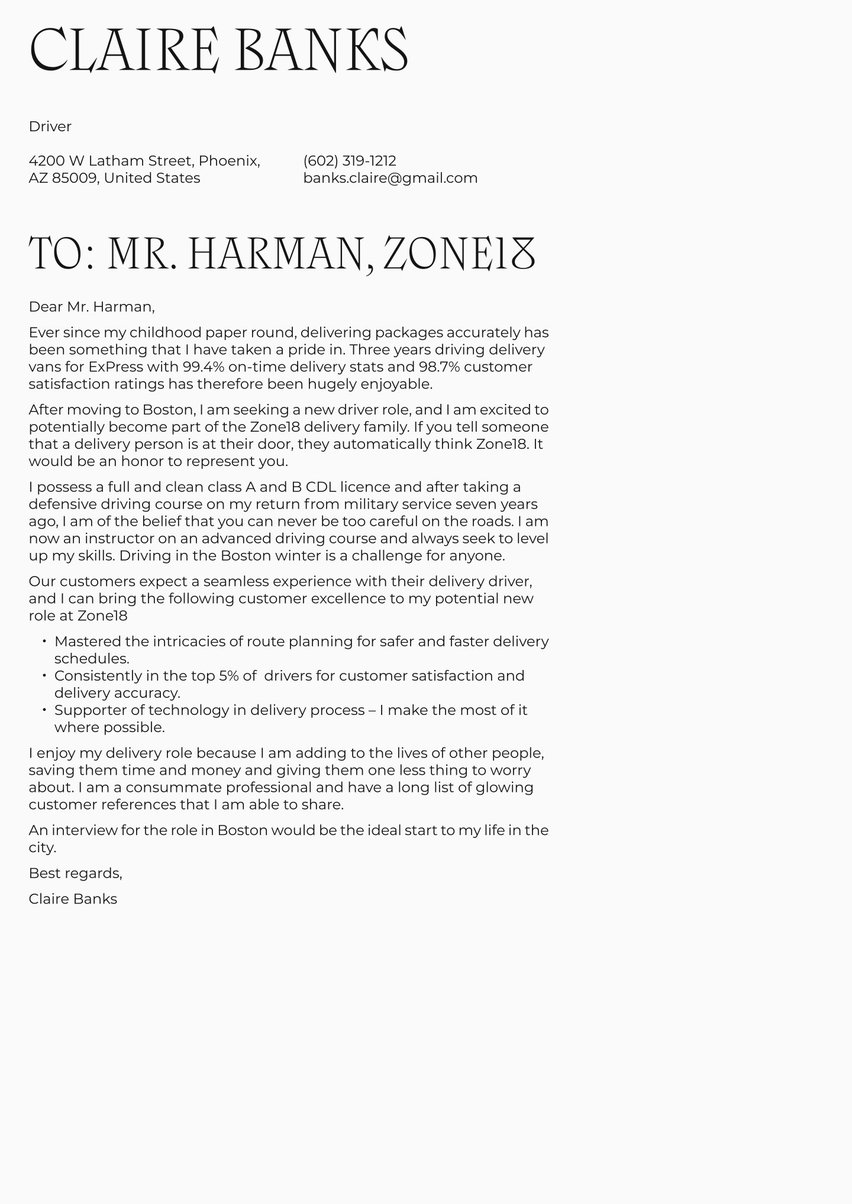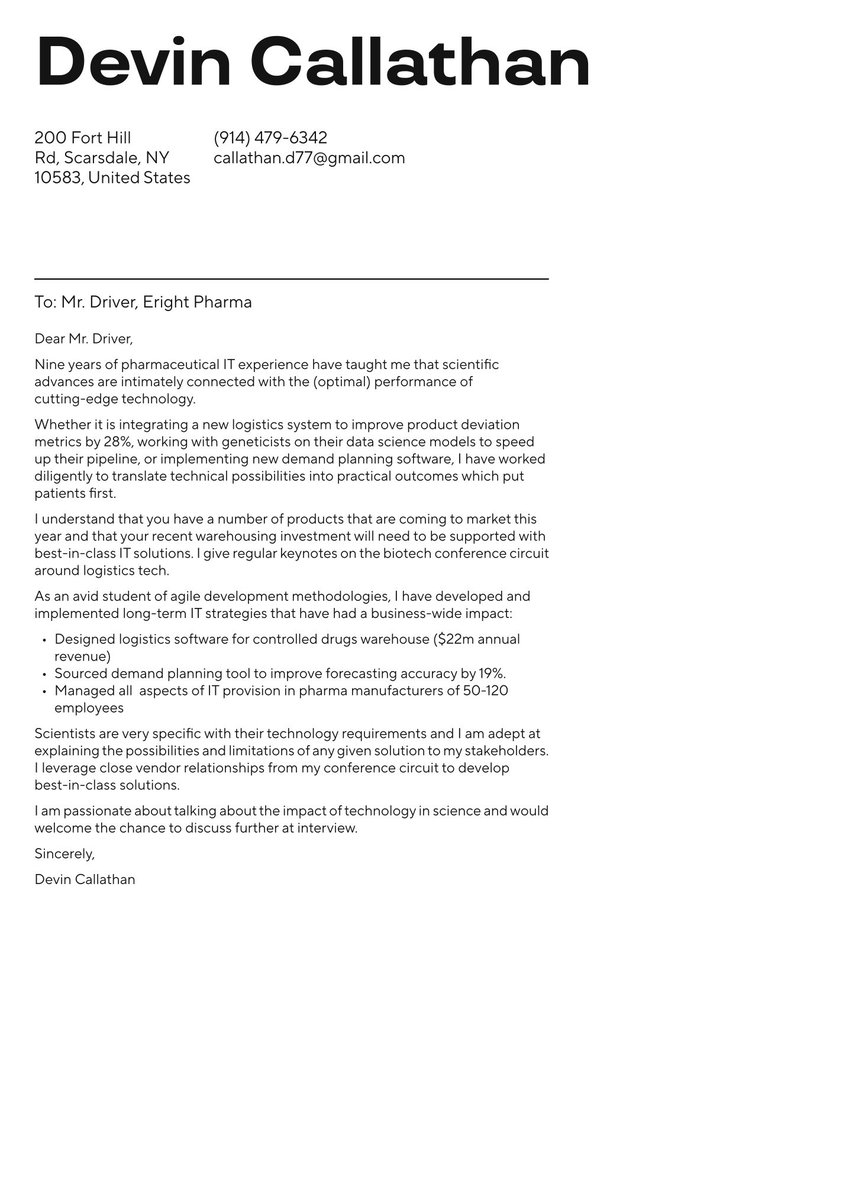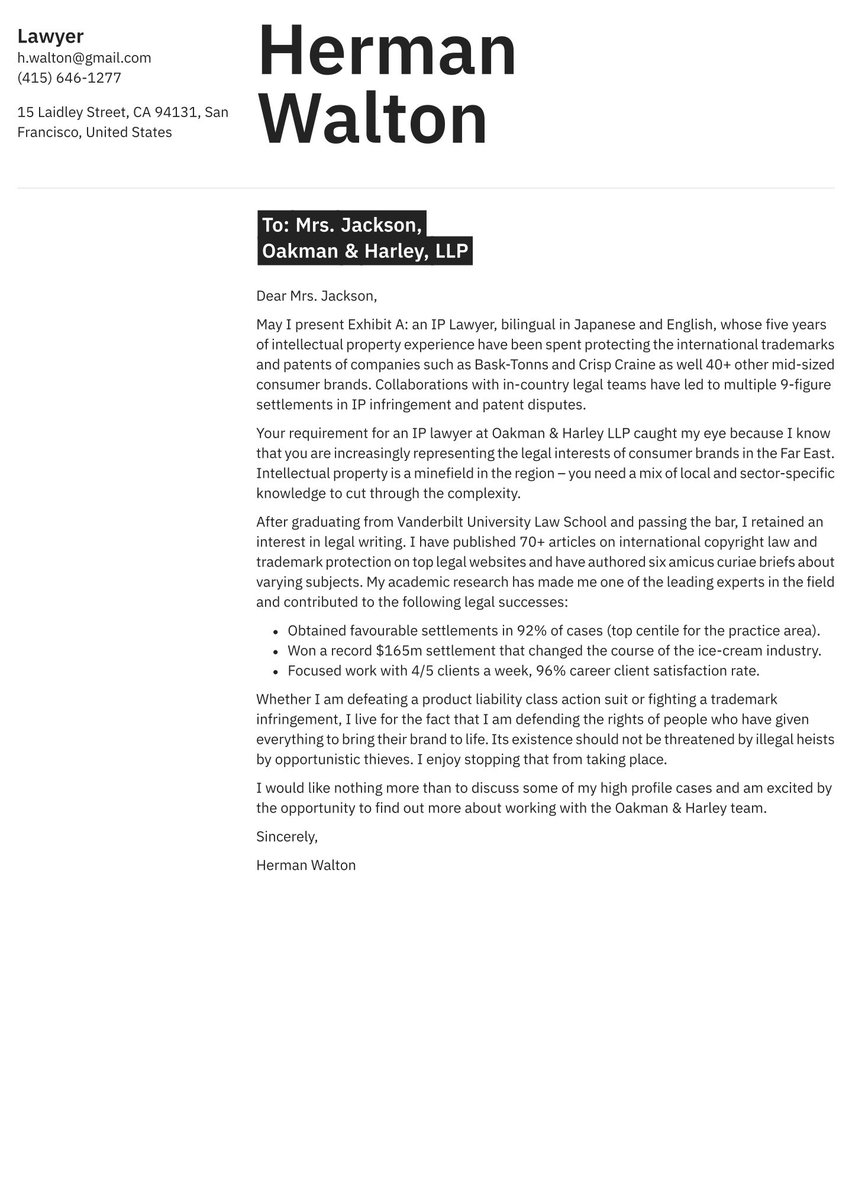Creating a standout cover letter for a graphic design role is similar to designing a stunning piece of art—both demand creativity, precision, and a strong attention to detail.
A lackluster cover letter might cause you to blend into the background. To make yours pop, be intentional about highlighting your design skills, your ability to think visually and innovatively, and your passion for translating ideas into impactful graphics.
Graphic design full text-only cover letter example
Dear Ms. Phipps,
In a world where attention is at a premium, award-winning graphics and show-stopping visuals are key to making customers stop and pay attention to the actual message. My 12 years of experience as a graphic designer have seen customers move onto social media and apps where, if they are not captivated, the swipe of a screen makes it so easy to move on.
Design036 is the top place in town for consumer advertising. Your leading consumer and hospitality clients need to bring their brands to life with arresting visual design, and you need a graphic designer who can translate your creative concepts into graphic reality. I have worked for your national competitors for many years, but after my move to Boston, I want to make your clients swoon with the power and simplicity of my work.
I have a BA in Graphic Design and am proficient in all major design, web, wireframe, and multimedia software. Working on 120+ graphic design projects every year has led to a deep understanding of how exactly to get my clients’ messages across.
Teasing out the best ideas early in the process leads to competitor-crushing success along the line. I hope you will agree that my achievements illustrate this:
- Designed the UX and GUI of a hospitality website, resulting in winning a national advertising award.
- Redesigned the packaging of a baking brand, resulting in a year-on-year sales increase of +75%.
- Revamped social media visuals for a travel business resulting in +160% engagement.
- Produced a playbook for all clients about graphics in search engine marketing led to +21% incremental business.
- Created style sheets and selected typography which were adopted across 60 clients via my previous employer.
I would love to discuss at an interview how my omnichannel visuals have transformed the fortunes of my past clients. I feel confident that I can do the same for your customers.
Sincerely,
Theodore Martin
Sections of a graphic design cover letter
When crafting your graphic design cover letter, leverage your creativity. Each section of your cover letter should clearly demonstrate why you're the best fit for the job.
- Header. Begin with your contact details and the date to present a professional appearance.
- Greeting. Address the hiring manager by name if possible, showing you’ve researched the company.
- Introduction. Start with enthusiasm for the graphic design role and briefly state your interest in the position.
- Body. Highlight your design skills and relevant experiences. Share specific achievements and how they align with the company’s needs.
- Conclusion. Summarize your qualifications and reiterate your excitement for the role.
- Signature. Close with a professional sign-off, including your name.
Ensure your cover letter is concise and engaging, no more than one page. Use it to weave your skills and experiences into a narrative that aligns with the company’s vision.
It’s not just about listing qualifications, but showing the reader how your unique design perspective and creative expertise make you the ideal candidate.
Need more inspiration? View our other related cover letter examples from the technology field.
For more general information and details that cover every section, view our article on how to write a cover letter.
Introduction of a graphic design cover letter
One of the most common, but laziest, ways to open a cover letter is by saying, “I am writing to express my interest…” In fact, “I am writing” is a phrase that should be eradicated from all cover letters—your recipients already know you are writing, so tell them something they don’t know.
The goal of the cover letter greeting is to make a direct personal connection with the hiring manager in a friendly, professional manner.
The introduction should usually be one provocative sentence that both identifies the job you’re seeking and offers a glimpse at your experience and qualifications to fill it.
Dear Ms. Phipps,
In a world where attention is at a premium, award-winning graphics and show-stopping visuals are key to making customers stop and pay attention to the actual message. My 12 years of experience as a graphic designer have seen customers move onto social media and apps where, if they are not captivated, the swipe of a screen makes it so easy to move on.
I am writing to express my interest in the graphic designer position at your company. I have some experience in graphic design and feel that my skills could be a good fit for your team. I am excited about the opportunity and hope to bring my creativity and work ethic to your organization.
Instead of a standard intro, kick off your graphic design cover letter by showcasing a standout project or achievement. This approach goes beyond listing skills and demonstrates how your work delivers real, impactful results aligned with the company’s needs.
Dear Ms. Phipps,
In a world where attention is at a premium, award-winning graphics and show-stopping visuals are key to making customers stop and pay attention to the actual message. My 12 years of experience as a graphic designer have seen customers move onto social media and apps where, if they are not captivated, the swipe of a screen makes it so easy to move on.
Graphic design cover letter body
In the body of your cover letter, follow a clear template.
- Highlight your skills and experience
- Show how you're a perfect fit for the school’s culture.
- Wrap up with a strong conclusion that leaves a lasting impression
- End with a compelling call to action that makes the hiring manager eager to contact you
First body paragraph: your suitability for the role (skills & experience)
Start your cover letter off strong by emphasizing your design skills and relevant experience that match the role’s requirements.
Here’s how to incorporate your expertise into your cover letter.
- Education. Highlight how your degree, certifications or courses have sharpened your design skills.
- Project experience. Share key projects and teamwork, emphasizing adaptability and problem-solving.
- Tech skills. Discuss your expertise with design software, computer skills and innovative approaches.
- Achievements. Detail specific projects or accomplishments that demonstrate impactful designs.
Second body paragraph(s): alignment with the organization
To effectively incorporate a company's needs into your cover letter, start by aligning your skills with their specific requirements. For instance, in this example, some key points that can be taken from the mission statement of the Design036 include:
- craft experiences that resonate
- dynamic and forward-thinking at the forefront of innovation
- collaborate with a passionate group of professionals who are committed to pushing boundaries
Emphasize how your background, such as working with national competitors, prepares you to excel in their unique environment. Show genuine enthusiasm for their mission, and express how your expertise can contribute to their success.
Tailoring your cover letter this way ensures that your application stands out and resonates with the company’s goals.
Design036 is the top place in town for consumer advertising. Your leading consumer and hospitality clients need to bring their brands to life with arresting visual design, and you need a graphic designer who can translate your creative concepts into graphic reality. I have worked for your national competitors for many years, but after my move to Boston, I want to make your clients swoon with the power and simplicity of my work.
I have a BA in Graphic Design and am proficient in all major design, web, wireframe, and multimedia software. Working on 120+ graphic design projects every year has led to a deep understanding of how exactly to get my clients’ messages across.
Teasing out the best ideas early in the process leads to competitor-crushing success along the line. I hope you will agree that my achievements illustrate this:
- Designed the UX and GUI of a hospitality website, resulting in winning a national advertising award.
- Redesigned the packaging of a baking brand, resulting in a year-on-year sales increase of +75%.
- Revamped social media visuals for a travel business resulting in +160% engagement.
- Produced a playbook for all clients about graphics in search engine marketing led to +21% incremental business.
- Created style sheets and selected typography which were adopted across 60 clients via my previous employer.
Call to action & conclusion: finish off strong
To close, you may want to ask if you could give the hiring manager a call next week, letting him or her know that you mean business. Or you may want to say that you’d be happy to schedule an interview, or at the very least that you’re looking forward to a response.
Keep this paragraph short, but make your correspondent feel that he or she should take some action after reading this letter. Exude confidence and determination, though without sounding demanding or entitled.
The purpose of this section of your cover letter is to end with a call to action that encourages the reader not to set aside and forget about your cover letter.
I would love to discuss at an interview how my omnichannel visuals have transformed the fortunes of my past clients. I feel confident that I can do the same for your customers.
Sincerely,
Theodore Martin
Conclude by signing off with your name. This isn’t just a formality; it’s your final touch that leaves a professional and memorable impression.
How to write a graphic design cover letter with no experience
Never fear if you have no experience. Even if you have not held a graphic design job you have skills that make you a great candidate. Here are some ways you can play up your graphic design influences:
Highlight transferable skills. Showcase how your previous roles have prepared you for a graphic design position. If you've worked in customer service or a team-oriented environment, emphasize how these experiences have sharpened your communication, collaboration, and problem-solving skills.
Emphasize tech knowledge. Highlight your experience with design software like Adobe Creative Suite, Figma, or other design tools. If you have coding skills, knowledge of UX/UI, or familiarity with AI-driven design programs, be sure to mention these as well.
Express your passion for creativity. Share your love for visual storytelling and design. Whether you enjoy experimenting with new design trends or teaching yourself new techniques, show how this passion aligns with a career in graphic design.
List freelance or volunteer experience. Include any design work you've done for events, non-profits, or small businesses. Even if it's unpaid, this type of experience highlights your commitment to developing your design skills and contributing to your community.
Include academic background. Mention any formal education in design, art, communication, or technology to showcase your foundational knowledge of design principles and industry trends.
Key takeaways
Your graphic design cover letter is your personal introduction to the hiring manager, an “elevator pitch” in writing that makes your case for employment by this company. This letter is a personal appeal, and it should seek to trigger both rational and emotional responses in the reader. Follow the proper structure for your cover letter—header, greeting, introduction, body and conclusion.
Check out our cover letter builder designed for graphic designers—a streamlined tool to create a standout, professional cover letter that boosts your job application and helps you land interviews!
